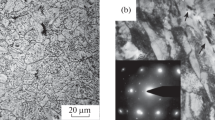The features of the microstructure and mechanical properties of the ferritic-martensitic steel EK-181 after warm isothermal forging in the ferritic region (tempforming) with the strain degree e ≈ 1.3 are studied. The formation of an inhomogeneous fragmented structure as a result of this processing is shown. The carbide subsystem does not change during processing. The mechanical properties of the steel have been studied under the conditions of tensile tests at 20 and 650°C accompanied by the microhardness measurements. It is shown that warm isothermal forging leads to some increase in the strength properties at room temperature. At an elevated temperature (650°C), the strength properties are comparable to those after traditional heat treatment (quenching and high-temperature tempering). The microhardness of steel after warm isothermal forging varied over the sample cross section from 2.7 GPa to 3.1 GPa. Tempering after multi-directional forging of the steel decreased its strength, but improved the plastic properties. The relationship between the microstructure and the mechanical properties of the EK-181 steel after isothermal forging in the ferritic region is discussed.
Similar content being viewed by others
References
X. Jin, Sh. Chen, and L. Rong, Mater. Sci. Eng. A, 712, 97 (2018); https://doi.org/10.1016/J.MSEA.2017.11.095.
L. Tan, J. T. Busby, P. J. Maziasz, and Y. Yamamoto, J. Nucl. Mater., 441, 713 (2013); https://doi.org/10.1016/j.jnucmat.2012.10.015.
Sh. Li, Z. Eliniyaz, F. Sun., et al., Mater. Sci. Eng. A, 559, 882 (2013); https://doi.org/10.1016/j.msea.2012.09.040.
Z. Xu, Y. Shen, Z. Shang, et al., J. Nucl. Mater., 509, 355 (2018); https://doi.org/10.1016/j.jnucmat.2018.04.025.
J. H. Zhou, Y. F. Shen, Y. Y. Hong, et al., Mater. Sci. Eng. A, 769, 138471 (2020); https://doi.org/10.1016/j.msea.2019.138471.
Sh. Yin, Y. Liu, and F. Zhao, Fusion Eng. Des., 173, 112785 (2021); https://doi.org/10.1016/j.fusengdes.2021.112785.
P. Shruti, T. Sakthivel, G. V. S. Rao, et al., Metall. Mater. Trans. A., 50, No. 10, 4582 (2019); https://doi.org/10.1007/s11661-019-05364-0.
P. Prakash, J. Vanaja, N. Srinivasan, et al., Mater. Sci. Eng. A, 724, 171 (2018); https://doi.org/10.1016/j.msea.2018.03.080.
A. Puype, L. Malerba, N. De Wispelaere, et al., J. Nucl. Mater., 494, 1 (2017); https://doi.org/10.1016/j.jnucmat.2017.07.001.
N. A. Polekhina, V. V. Linnik, I. Yu. Litovchenko, et al., Metals, 12, 1928 (2022); https://doi.org/10.3390/met12111928.
I. Litovchenko, K. Almaeva, N. Polekhina, et al., Metals, 12, No. 1, 79 (2022); https://doi.org/10.3390/met12010079.
K. V. Almaeva, N. A. Polekhina, V. V. Linnik, and I. Yu. Litovchenko, AIP Conf. Proc., 2167, 020013 (2019); https://doi.org/10.1063/1.5131880.
A. Dolzhenko, A. Pydrin, S. Gaidar, et al., Metals, 12, 48 (2021); https://doi.org/10.3390/met12010048.
A. Dolzhenko, R. Kaibyshev, and A. Belyakov, Metals, 10, 1566 (2020); https://doi.org/10.3390/met10121566.
Y. Kimura and T. Inoue, ISIJ Int., 60, 1108 (2020); https://doi.org/10.2355/isijinternational.ISIJINT-2019-726.
H. Jiang, Y. Liu, Y. Wu, et al., J. Mater. Eng. Perform., 28, 3505 (2019); https://doi.org/10.1007/s11665-019-04111-1.
Y. Nakao and H. Miura, Mater. Sci. Eng. A, 528, 1310 (2011); https://doi.org/10.1016/j.msea.2010.10.018.
V. Soleymani and B. Eghbali, J. Iron Steel Res. Int., 19, 74 (2012); https://doi.org/10.1016/S1006-706X(12)60155-1.
Author information
Authors and Affiliations
Corresponding author
Rights and permissions
Springer Nature or its licensor (e.g. a society or other partner) holds exclusive rights to this article under a publishing agreement with the author(s) or other rightsholder(s); author self-archiving of the accepted manuscript version of this article is solely governed by the terms of such publishing agreement and applicable law.
About this article
Cite this article
Linnik, V.V., Polekhina, N.A., Litovchenko, I.Y. et al. Microstructure and Mechanical Properties of the Ferritic-Martensitic Steel EK-181 After Warm Isothermal Forging. Russ Phys J 66, 404–409 (2023). https://doi.org/10.1007/s11182-023-02954-9
Received:
Published:
Issue Date:
DOI: https://doi.org/10.1007/s11182-023-02954-9



